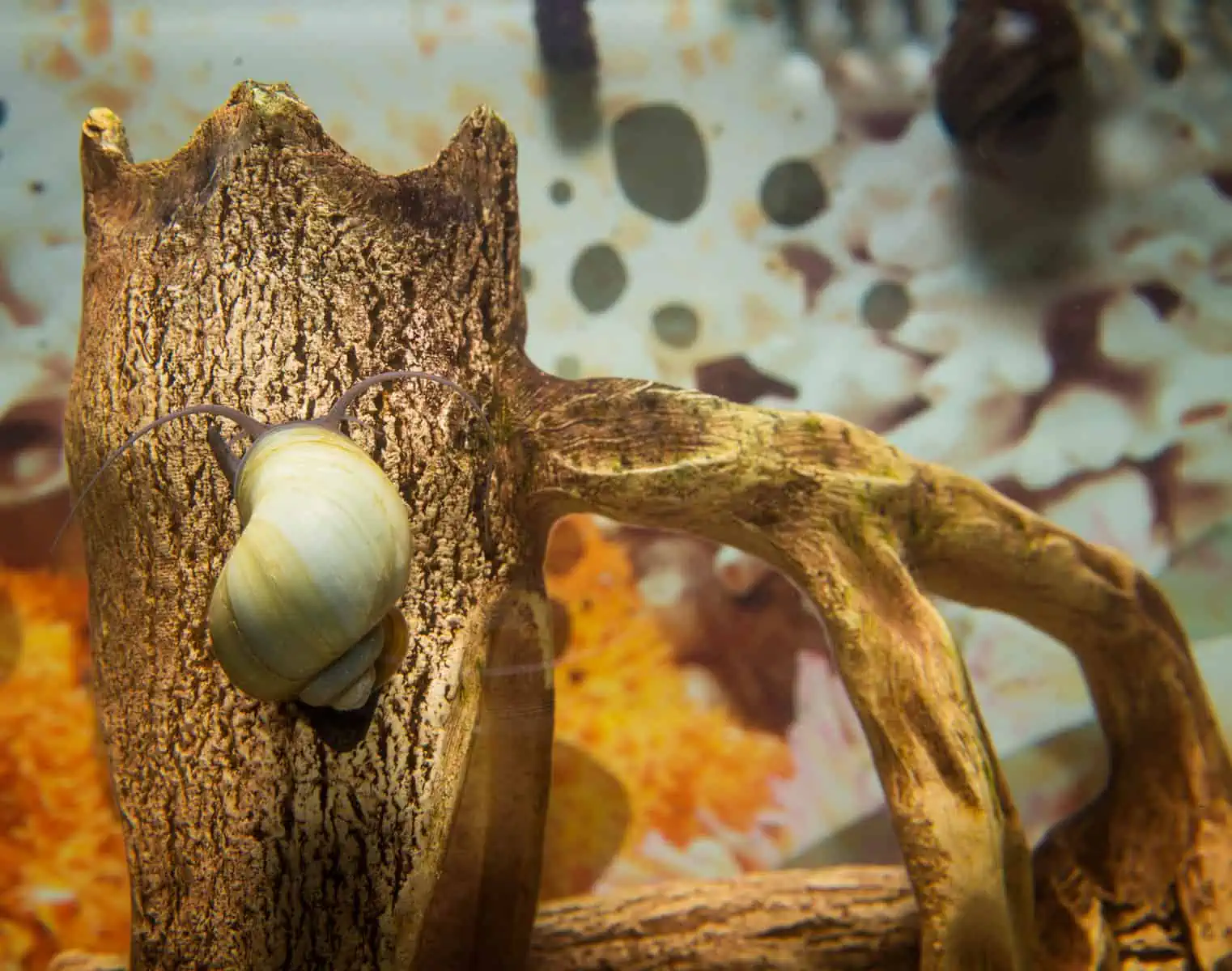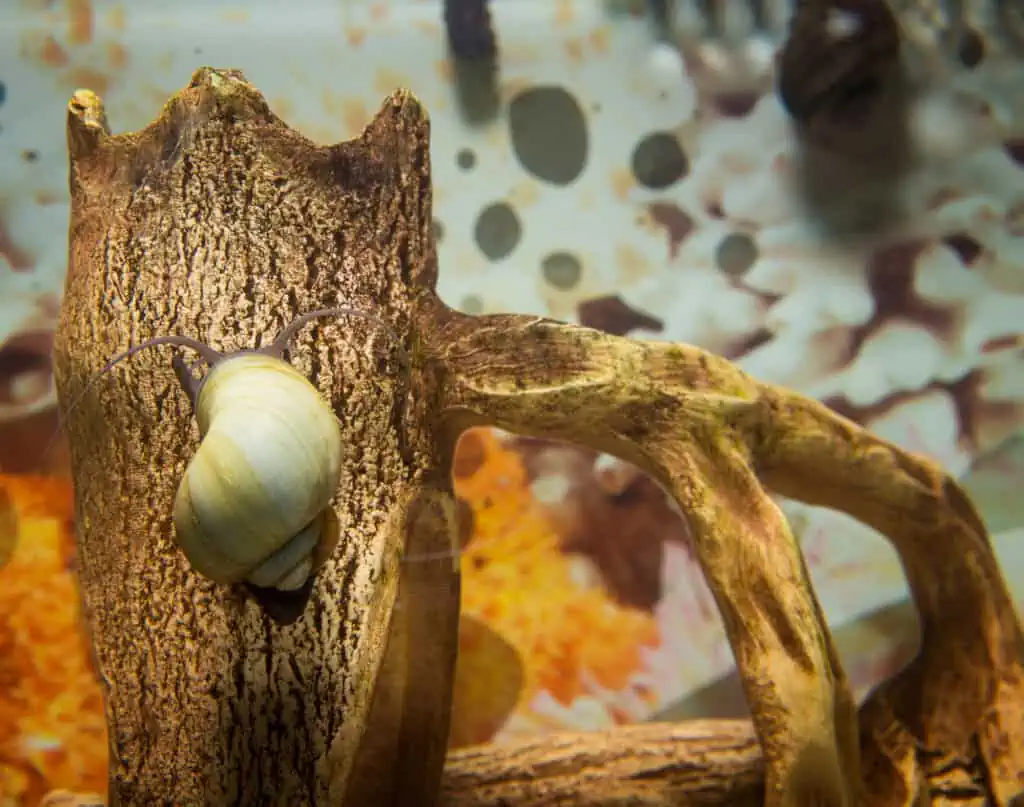If you’ve noticed your mystery snail’s shell becoming thinner, more pale, cracked, deformed, or damaged, it may be suffering from snail shell erosion or ‘shell rot’. This can be due to several factors, but acidic water is often one of the root causes.
Here I’ll run you through some of the main causes of shell rot and how to help your aquarium snail make a full recovery.
Why Is My Mystery Snail’s Shell Damaged?
Acidic Water
Although it’s unlikely to be the sole cause of a cracked shell, acidic water is the most likely contributing cause of a mystery snail’s shell becoming damaged.
Healthy snails need neutral to alkaline water. If the tank water has a pH of less than 7, their shells could start eroding due to the acidity of the water. As their shell gradually becomes thinner, weaker, and lighter in color, they also become more susceptible to cracks, damage, or deformation.
Low Calcium Diet
The second most common cause for a pet snail’s shell to weaken is a lack of calcium in its diet. This is less likely in tanks with a high pH since alkaline water conditions promote a higher calcium content in the algae that the snails eat.
In lower pH water conditions, however, there may not be enough available calcium in the snail’s diet to harden its shell properly.
Lack of Food
A mystery snail’s shell may also become weak when they are lacking enough food. In an aquarium, we’re talking mostly about algae.
Even if the water has a high pH, if there is not enough algae for them to eat, your snails will become hungry, weakened, and their shells will begin to soften and erode.
Attacked by a Fish
While acidic water and an insufficient diet will weaken a snail’s shell, an actual crack is often inflicted by some sort of injury.
This could be due to an aggressive or predatory fish in the tank that has tried to attack your snail. Cichlids, catfish, gouramis, and loaches are known for attacking snails, and may be trying to get to their soft, tasty flesh!
If you want to preserve your mystery snails, you should check out my list of fish that can eat snails, so you know which fish species to avoid!
Falling Out of the Fish Tank
Mystery snails are notorious for escaping from aquariums. Because they have both gills and lungs, mystery snails can breathe out of the water as well as when submerged.
Mystery snails are especially prone to escaping the tank when they are hungry, looking for mating opportunities, or when there is poor water quality in the fish tank.
As you can imagine, falling out of the tank can easily crack your snail’s shell, so be sure to check them over thoroughly if you find them on the floor.
Copper Exposure
Like all mollusks, mystery snails are highly intolerant of copper. Even small amounts dissolved in the water can cause a pet snail to become unwell and die. One of the symptoms of this may be a white, brittle shell.
Copper medications are often used to treat common fish diseases such as ich, but some fish keepers using them sadly don’t realize that they are highly toxic to snails.
Warm Water Temperature
Mystery snails can tolerate a wide range of water temperatures, and are suitable for both cold water and tropical aquariums, with a temperature range between 68-82°F often being quoted as the optimum bracket.
Research from Argentina, however, indicates that mystery snails living in very warm water will tend to have thinner shells than those living in cold water. It’s just another small consideration to make when trying to create the ideal tank environment for your snails.
Optical Illusion!
The last cause on our list is not really a cause of a snail’s shell cracking, but it could cause you to think that it has!
The lines on a mystery snail’s shell can sometimes appear to be a crack, when in fact there is no damage at all. This is why it’s always essential to gently remove your snails from the aquarium to examine their shell closely before attempting any treatment.
How Do Snails Repair Their Shells?
For this kind of question, it’s better to turn to empirical scientific research than to ask Bill who lives next door! Although I couldn’t find any scientific studies on mystery snails (Pomacea bridgesii) specifically, I did find scientific experiments carried out on Helix aspera, the garden snail.
Scientists discovered that these land snails repaired small holes in their shells by transporting calcium carbonate and proteins from other parts of the shell, or their digestive glands into a mantle and a special healing fluid.
Once applied to the damaged area, these rapidly calcify into a protein membrane. Additional calcified membranes are layered on top until a firm repair is completed, sometimes in as little as 24 hours!
In cases of very large cracks or severe damage, however, the problem may be too great to repair, and sadly, the snail may die.
Can a Snail Survive with a Damaged Shell?

Your snail may be able to survive for a short time with a damaged shell, but in the long run, the crack will either need to heal or it could cause further problems, making your snail vulnerable to attack and potential infections.
Although your snail will do its best to repair its shell, you need to provide the best possible conditions for the healing to take place.
Treating a Damaged Snail Shell
To aid the healing process, it’s important to correct whatever conditions caused the damaged shell to begin with:
Test Your Tank Water
To see if your water parameters are adequate for keeping mystery snails, you’ll need to test your water. Use an aquarium water test kit to find out the pH of your water. If it’s less than 7, you’ll need to make it more alkaline.
Although others have also recommended using a calcium test kit, a general pH measuring kit usually indicates if you have enough calcium in the water.
Make Your Water More Alkaline
If your pH test reveals that your water is too acidic for your snails to maintain healthy shells, you’ll need to make conditions more alkaline for it to heal.
Good ways to make tank water more alkaline include adding alkalizing agents such as baking soda and liquid additives, or items that are high in calcium carbonates such as limestone and sea shells. Crushed coral should only be if it’s derived from a sustainable source.
Reduce CO2 Injection
Since dissolved CO2 makes water more acidic, you may need to consider turning down your CO2 injection system if you’re using one for a planted aquarium.
Provide a High Calcium Diet
Cuttlebone is a very popular high-calcium supplement for aquatic snails. If you’ve never heard of this, you may be surprised to learn that this internal bone of the cuttlefish can be fed to aquatic pets as well as caged birds. Cuttlebone is also an excellent source of calcium for other aquarium crustaceans such as crabs and crayfish.
Cuttlebone tends to be readily available from pet stores, but if you’re struggling to obtain it, you could also try feeding your snails chicken egg shells that have been boiled and smashed up as a good calcium alternative.
Remove Aggressive Tank Mates
If you think your fish might be to blame for your snail shell deterioration, you will either need to remove the culprit fish or your snails to avoid further injuries.
If you don’t have a second tank, you could try taking your fish or snails to a pet store, which will normally accept unwanted pets.
Keep Your Snails Happy and a Tight Lid on Your Tank
If your snail’s shell has been damaged by escaping from the tank, you need to consider the root cause of your snail attempting the escape.
If they don’t have enough algae to eat, try feeding them algae wafers. If your tank’s water quality is not good, then try improving it by using a more efficient filter, changing your tank water more often, vacuuming regularly, and reducing the amount of food you’re giving to your fish.
Remove Copper From the Aquarium
If you suspect your snails may have suffered from copper poisoning, you need to remove them immediately and keep them in another tank with clean, treated water. If you’re lucky, they might recover.
After you’ve used any type of copper medication, an aquarium must always be cleaned by making several partial water changes and using a carbon filter to remove any remaining copper traces before pet snails can be reintroduced.
Conclusion
Mystery snails can sometimes suffer from shell erosion or ‘shell rot’ which causes their shell to become more brittle and prone to cracking. Identifying the factors that contributed to shell rot and correcting them is the key to helping your snails make a full recovery.
To find out more about caring for your mystery snails, check out our dedicated care guide here.


